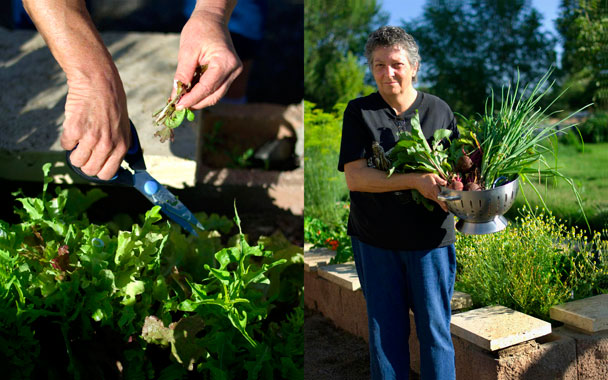Eight of us crowded around Grandma’s bed as wheelchairs and walkers passed through the hallway. Someone mentioned the generally dismal food found in American assisted-living facilities, and then someone else made passing reference to a menu offering “puréed pulled pork.” Granted, many of the aged have no teeth, and others can’t stomach anything crunchy, raw, or pungent. But pork in a blender?
Enter the Center for Ageless Living in Los Lunas, New Mexico, and smell a homemade custard apple pie baking in the oven. Wander the gardens and pluck a delightfully green peppermint sprig. Take a yoga class, get a Swedish massage, soak in the hot tub and know that when you are through, the water will enter a septic system that turns 6,000 gallons a day into gray water to feed a lily pond and flower garden.
This is Director Suzette Lindemuth’s dream in the works: an assisted-living facility with sustainability a top priority and graceful aging a primary goal. Her center not only houses 45 residents but welcomes the public in myriad ways—with classes in Tai Chi; a day spa; a rotisserie serving chicken with locally grown herbs; a community park; and grounds for weddings, concerts, and conferences. This six-acre campus, about 25 miles south of Albuquerque near the Rio Grande, radiates greenery. Well-water irrigation sustains everything edible, while ornamentals live off the recycled pool and hot tub water (no chlorine is used, only ozone and bromine).
Raised beds flourish with fennel, mustard greens, beets, lettuce, basil, and tarragon. The orchard packs plums, peaches, almonds, cherries, quince for pectin, and jujubes for jelly. Ann Sesler, the center’s culinary specialist, leads me through a maze of tomatoes, about a third of an acre with 113 plants and 14 varieties. “There’s just nothing like them,” she says, handing me a fresh pick that bursts in my mouth. “We lost some tomatoes last week to the hornworms,” she says. “That’s what happens when you don’t use pesticides.”
Lindemuth says that, in traditional assisted-living facilities, delivery trucks often supply the entire kitchen. But, she adds, “there’s no reason you can’t have really good food in a health-care setting. It’s expensive. So maybe you don’t have to eat quite as much.”
And here’s the kicker: This isn’t a spa retreat for the elite. “We take a lot of low-income seniors,” she says. A monthly rent of approximately $2,800 covers all resident care and services, three meals a day, and on-site activities. Residents have full access to all spa facilities (plus they can bring a relative).


